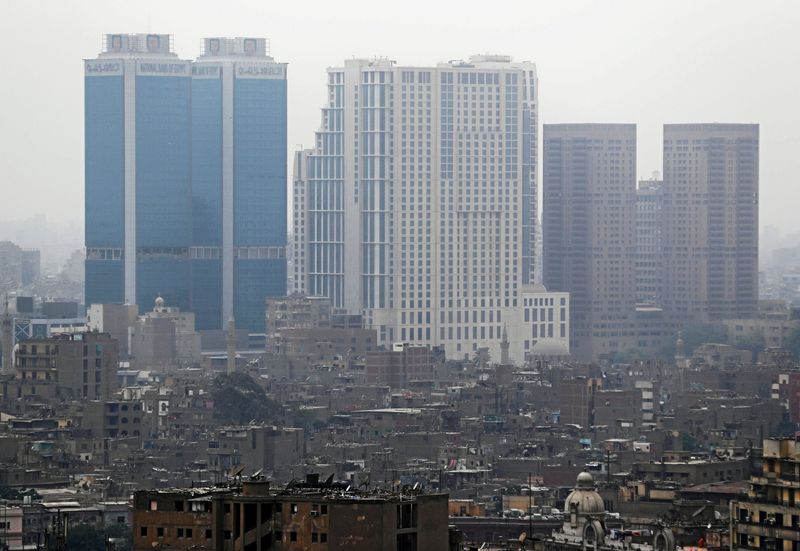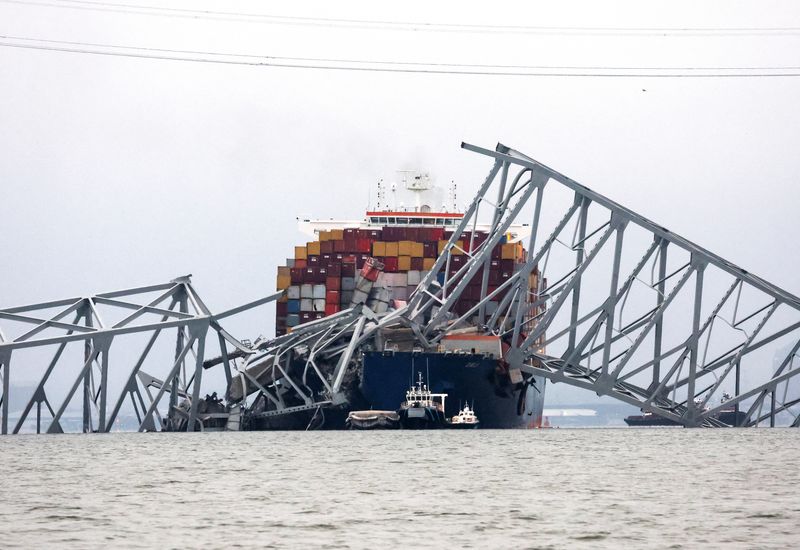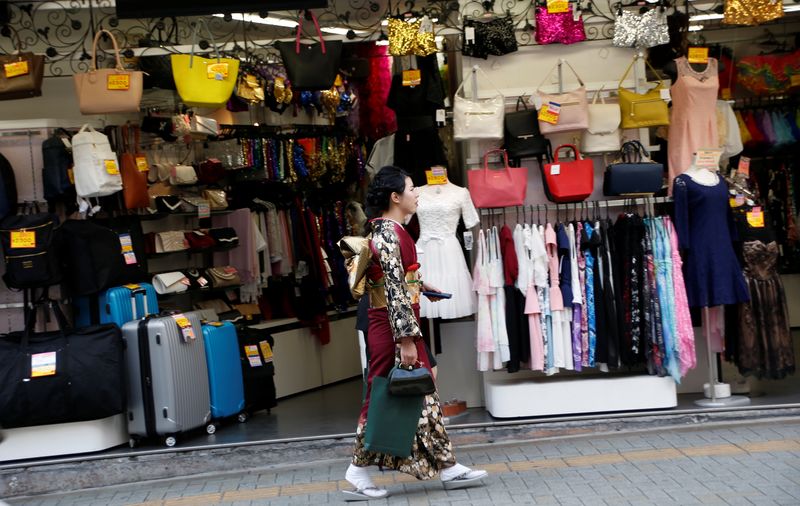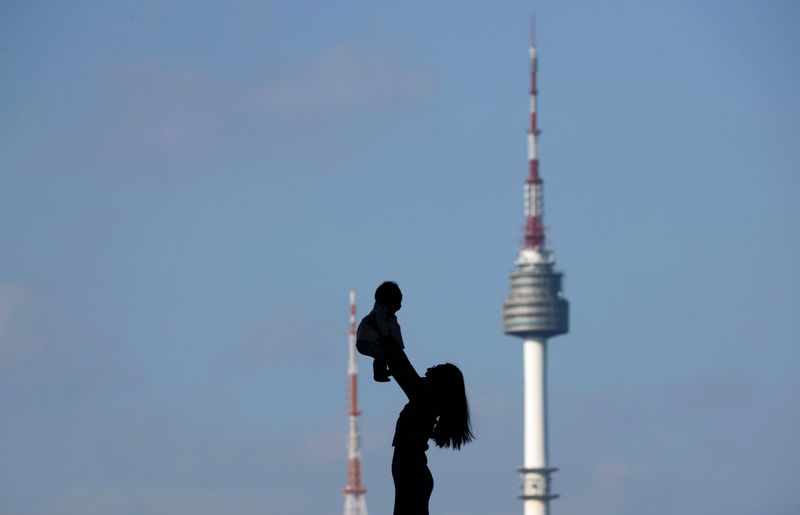Select Language

By Nafisa Eltahir and Patrick Werr
CAIRO (Reuters) -The IMF will tie payments to Egypt under an $8 billion financial programme to Cairo's letting market conditions determine the price of its currency and its making foreign exchange available to businesses and private individuals, the IMF said on Monday.
Egypt, which signed the loan agreement on March 6, will have immediate access to $820 million this week and another $820 million after a review to be completed by the end of June.
Subsequent reviews will be made every six months, with each unlocking payments of $1.3 billion provided certain conditions are met, with the last payment in autumn of 2026, mission chief Ivanna Vladkova Hollar told a news conference.
The International Monetary Fund's executive board approved the programme on Friday, expanding on a $3 billion Extended Fund Facility signed in December 2022 after the crisis in neighbouring Gaza further shook Egypt's already precarious economy.
Egypt allowed its currency to weaken sharply after the 2022 agreement, but within months had re-pegged it to the dollar, prompting the IMF to put the programme on hold.
Under last month's agreement Egypt again let its currency plunge and has since let its price fluctuate.
"This is an important reform that needs to be sustained. It's not a one-off reform," Hollar said.
"At each individual review, the expectation is that the conditions that we're seeing now in the market are going to continue to hold, in the sense that we do not see a return to a system of FX rationing and lack of FX availability," she said.
The Gaza crisis exacerbated Egypt's chronic foreign crisis by slowing tourism growth and triggering attacks from Yemen on shipping in the Red Sea, halving Suez Canal revenue. Tourism and canal revenue are two of its main sources of foreign exchange.
Among other reforms the IMF is seeking is that Egypt ensure a level playing field between private and state firms and that the state reduce its role in the economy.
An additional loan from the IMF's Resilience and Sustainability Facility would be discussed during the next review, Vladkova Hollar said.
"To qualify, countries need to have in place a strong set of policies that are intended to address the bases of climate change," she added.
The IMF forecasts that Egypt's inflation will remain high in the near term, with average inflation for the coming fiscal year, which begins on July 1, expected at 25.5%, falling to 15.25% by the end of that year, she said. Inflation rose to a record high of 38% in September before easing in February to 35%.
The country, whose budget has been stretched in recent years, needs to replace untargeted fuel subsidies with targeted spending designed to reach households in need, she added.
Egypt raised fuel prices late last month as part of a programme to reduce subsidies. Fuel subsidies would continue to fall as part of Egypt's quarterly pricing committee meetings, Hollar said.

By Leika Kihara
TOKYO (Reuters) - Japanese Finance Minister Shunichi Suzuki said on Tuesday that authorities were ready to take appropriate action against excessive currency market volatility, without ruling out any options.
"We are carefully watching daily market moves," Suzuki told a news conference after a regular cabinet meeting, when asked about the yen's continued declines.
"We are watching currency moves with a strong sense of urgency," he said.
The yen has been on a downtrend despite the Bank of Japan's decision on March 19 to end eight years of negative interest rates, and hit a 34-year low against the dollar at 151.975 last week. It stood at 151.655 in Asia on Tuesday.
With the BOJ's policy rate still stuck around zero, expectations the gap between U.S. and Japanese interest rates will remain wide are giving traders an excuse to keep selling the yen, analysts said.
Suzuki said monetary policy was only among many factors that affect currency moves, such as each country's current account balance, price developments, geo-political risks, market sentiment and speculative moves.
"It's important for currency rates to move stably reflecting fundamentals. Excessive volatility is undesirable," he said.
Suzuki declined to comment when asked whether Japan would intervene heavily in a single blow to unwind speculative positions, or conduct intervention in several stages to smooth volatile moves.

SANTIAGO (Reuters) - Chile's economic activity index posted its largest year-on-year increase in almost two years in February, central bank data showed on Monday, reinforcing its positive momentum after a major beat in the previous month.
Economic activity in the world's largest copper producer was up 4.5% in February from a year earlier, the central bank said, the most since May 2022, when it had risen 5.1%.
All activities surveyed by the monetary authority had a positive performance in the month, with mining and services - especially transportation - among the highlights.
A number of independent analysts had already pointed out last week that economic activity growth of more than 4% in February was on the cards after sectoral statistics confirmed a good start to the year for the Andean country.
The result, however, still came in as a surprise for analysts polled by the central bank, whose median forecast for activity in February stood at a 1.5% expansion, according to a poll released last month.
The data comes after Chile's economic activity rose by a revised 2.3% year-on-year in January, overshooting market estimates.
The Monthly Economic Activity Indicator (Imacec), which represents about 90% of gross domestic product (GDP), was also up 0.8% in February from the previous month.
"In all, the momentum of both ex-mining and mining activity has clearly outpaced our expectations," JPMorgan economist Diego Pereira said, noting that accommodative fiscal policy and less restrictive monetary policy have provided a boost.
"The question is whether mining would be able to consolidate this level, gain further, or drop in a similar manner to what happened in the prior two years."
Chile faced a sharp economic downturn in 2023 after a rapid post-pandemic recovery. The economy struggled while consumer prices soared, leading the central bank to hike interest rates which it has now been cutting as inflation cooled.
The latest rate cut came in January, when the bank reduced borrowing costs by 100 basis points. The monetary authority's rate-setting committee will meet again this week and is expected to deliver a 75-basis-point rate cut to 6.50%.

By Florence Tan
SINGAPORE (Reuters) -Oil prices rose on Monday, adding to recent gains amid expectations of tighter supply from OPEC+ cuts, attacks on Russian refineries and as upbeat Chinese manufacturing data supported outlooks for improving demand.
Brent crude rose 24 cents, or 0.3%, to $87.24 a barrel by 0649 GMT after rising 2.4% last week. U.S. West Texas Intermediate crude was at $83.45 a barrel, up 28 cents, or 0.3%, following a 3.2% gain last week.
Trade volumes are expected to be thin on Monday as several countries are closed for Easter holidays.
Both benchmarks finished higher for a third consecutive month in March, with Brent holding above $85 a barrel since the middle of last month, as the Organization of the Petroleum Exporting Countries (OPEC) and their allies, a group known as OPEC+, pledged to extend production cuts to the end of June which could tighten crude supply during summer in the Northern Hemisphere.
Russian Deputy Prime Minister Alexander Novak said on Friday that its oil companies will focus on reducing output rather than exports in the second quarter in order to evenly spread production cuts with other OPEC+ member countries.
Drone attacks from Ukraine have knocked out several Russian refineries, which is expected to reduce Russia's fuel exports.
"Geopolitical risks to crude and heavy feedstock supplies add to strong Q2 24 demand fundamentals," Energy Aspects analysts said in a note.
Almost 1 million barrels per day (bpd) of Russian crude processing capacity is offline from the attacks, impacting its high-sulphur fuel oil exports which are processed at Chinese and Indian refineries, the consultancy added.
In Europe, oil demand was firmer than expected, rising 100,000 bpd on year in February, Goldman Sachs analysts said, versus its forecast of a 200,000 bpd contraction in 2024.
Europe's firm demand, softness in U.S. supply growth coupled with a possible extension of OPEC+ cuts through 2024 outweigh downside risk from persistent softness in China's demand, they said in a note.
Crude oil production by the United States, the world's largest producer, dropped 6% in January from December's record high, following freezing weather, data from the Energy Information Administration showed on Friday.
"We see the risks to our forecast that Brent will average $83/bbl in 2024Q4 as skewed moderately to the upside," the analysts said.
Also supportive for prices, China's manufacturing activity expanded for the first time in six months in March, an official factory survey showed on Sunday, supporting oil demand at the world's largest crude importer, even as a crisis in the property sector remains a drag on the economy.
Investors are also scouring U.S. economic data for signs of when the Federal Reserve will cut interest rates this year which will support the global economy and oil demand.

By Gabriella Borter
WASHINGTON (Reuters) -With efforts underway to clean up thousands of tons of steel debris from the collapsed bridge in Baltimore's harbor, Maryland Governor Wes Moore on Sunday urged Republicans to work with Democrats to approve the federal funding needed for rebuilding the bridge and to get the port economy back on its feet.
Baltimore's Francis Scott Key bridge collapsed early on Tuesday morning, killing six road workers, when a container ship nearly the size of the Eiffel Tower lost power and crashed into a support pylon. Much of the span crashed into the Patapsco River, blocking the Port of Baltimore's shipping channel.
The Biden administration released $60 million in initial emergency aid on Thursday to assist in cleaning up the bridge debris and reopening the port, which is the largest in the U.S. for "roll-on, roll-off" vehicle imports and exports of farm and construction equipment. The port has been closed since Tuesday, leaving in limbo the jobs of some 15,000 people who rely on its daily operations.
Federal officials have told Maryland lawmakers the final cost of rebuilding the bridge could soar to at least $2 billion, Roll Call reported, citing a source familiar with the discussions.
Democratic President Joe Biden has pledged that the federal government will cover the cost, but that will depend on passage of legislation authorizing the funds by both the Republican-led House of Representatives and Democratic-led Senate. The divided Congress has been repeatedly riven by partisan battles over funding, with hardline Republicans often at odds even with members of their own party.
Moore, a Democrat, said Republicans should be willing to approve the funding for the sake of not just the city of Baltimore, but for the national economy.
"The reason that we need people to move in a bipartisan basis ... is not because we need you to do Maryland a favor," Moore told CNN on Sunday. "We need to make sure that we're actually moving quickly to get the American economy going again, because the Port of Baltimore is instrumental in our larger economic growth."
Secretary of Transportation Pete Buttigieg expressed optimism on Sunday that Congress would approve the funds necessary for the cleanup and rebuild, noting that the divided legislative body had passed Biden's $1 trillion infrastructure package in 2021.
"If there's anything left in this country that is more bipartisan than infrastructure, it should be emergency response. This is both, and I hope that Congress will be willing if and when we turn to them," Buttigieg told CBS's "Face the Nation."
Biden was expected to visit the bridge collapse site this week.
An enormous crane began cutting up portions of the collapsed bridge to prepare them for removal on Saturday, which officials said was the first step of what will be a long and complicated cleanup. A spokesperson for the governor's office said on Sunday that a 200-ton (180-metric ton) piece of the bridge had been removed and officials were working to determine the best strategy for pulling the ship off the wreckage.
Later Sunday officials said they were preparing to establish an alternate route for "commercially essential vessels," although few additional details were released and the timing of the alternate route's opening wasn't made clear.
In a statement, coordinator Capt. David O'Connell said that the alternate would "support the flow of marine traffic into Baltimore." Video released by responders showed Coast Guard officials dropping buoys into the water near the site of the collision.
The wreckage and hazardous weather conditions have made it impossible for divers to continue searching for the four remaining bodies of the deceased construction workers in recent days, Moore said.
Moore and other officials have declined to give an estimated timeline for the reopening of the port and the rebuilding of the bridge.

BANGKOK (Reuters) - Thailand's economic growth is expected at 2.8% this year before accelerating to 3.0% in 2025, the World Bank said on Monday.
The growth outlook for 2024 and 2025 was reduced from 3.2% and 3.1% respectively, as forecast in December. Southeast Asia's second-largest economy expanded 1.9% in 2023.

Japan's service sector sentiment rises to highest in over three decades

Investing.com -- U.S. employment data on Friday will be the main highlight of this week’s economic calendar amid hopes the economy is on course for a soft landing. The second quarter gets underway after a stellar performance for stocks in Q1. The yen and the yuan remain on intervention watch while data out of the Eurozone and China will be closely watched. Here’s what you need to know to start your week.
Nonfarm payrolls
Friday’s jobs report will be in the spotlight amid investor confidence that the economy is set for a "soft landing", in which inflation moderates but the economy avoids a severe downturn.
The U.S. economy is expected to have added 205,000 jobs in March, slowing from the 275,000 jobs added in February.
Hopes for a "soft landing" for the economy were boosted after the Fed at its March meeting stuck to its view of three rate cuts this year while upgrading its outlook for economic growth.
Ahead of the jobs data, investors will also get a chance to hear from several Fed officials including Fed Chair Jerome Powell on Wednesday. Among others due to make appearances are New York Fed President John Williams, San Francisco Fed head Mary Daly and Richmond Fed head Thomas Barkin.
Q2 kicks off
The U.S. stock market has had a strong start to the year, boosted by optimism over artificial intelligence related stocks and expectations the Fed will begin to cut interest rates this year.
Each of the three main U.S. indexes recorded solid quarterly gains, led by a climb of over 10% for the S&P 500 for its biggest first-quarter gain since 2019.
Whether that rally continues into the second quarter is largely down to the Fed. At the start of the year markets had been expecting six rate cuts from the Fed – now just three are priced in and officials have not yet signalled that inflation has come down enough to justify a rate cut.
Continued strong momentum will also depend on corporate earnings which get underway in earnest the second week in April.
Intervention watch
Monetary authorities in Japan and China are on high alert as their currencies weaken past levels that they've been defending for months, largely thanks to the strong dollar.
With the yen faltering towards the 152 per dollar level and the yuan struggling to break above the stronger side of 7.2 per dollar, officials have stepped up efforts to bolster their currencies.
In Japan, that means verbal warnings, while in China it has been state banks buying yuan and selling dollars.
Given how much the two big Asian currencies have fallen, there's a growing school of thought that Beijing could have grown more tolerant of a weak yuan to maintain its competitive edge against the yen but it’s hard to say what’s next.
Eurozone inflation
The Eurozone is to release flash inflation data for March on Wednesday that will be closely watched amid speculation that the European Central Bank is gearing up to cut rates in June.
Inflation in the euro area remained high since the start of the year and needs to fall further to allow the ECB to deliver a summer rate cut, making the next three inflation reports key for markets (and the ECB).
If inflation surprises to the upside, rate cut bets will be pushed out.
Speaking Saturday, ECB Governing Council member Robert Holzmann said it could lower its key interest rate before the Fed, noting that the European economy was growing more slowly than its U.S. counterpart.
China data
China's manufacturing activity expanded for the first time in six months in March, according to official data published on Sunday, offering relief to policymakers even as a crisis in the property sector remains a drag on the economy and confidence.
Expectations are for Monday’s Caixin manufacturing PMI to show a slight expansion, likely continuing its divergence with the official reading - overall offering a mixed outlook for the world's No.2 economy.
Policymakers have wrestled with persistent economic sluggishness since the abandonment of COVID curbs in late 2022, amid a deepening housing crisis, mounting local government debts and weakening global demand.
(Reuters contributed reporting)

By Cynthia Kim and Jihoon Lee
SEOUL (Reuters) - South Korea is launching a high-speed train service that will reduce the travel time between central Seoul and its outskirts, a project officials hope will encourage more youth to consider homes outside the city, and start having babies.
South Korea has the world's lowest fertility rate, and its youth have often cited long commutes and cramped, expensive housing in greater Seoul, home to about half the population, as the main reasons for not getting married and starting a family.
The birth rate in Seoul is even lower than the national average, and the government has tried to boost the number of newborns through subsidies, with little success.
Officials are now pinning their hopes on the Great Train eXpress (GTX), a 134 trillion won ($99.5 billion) underground speedtrain project that, by 2035, will provide six lines linking Seoul to several outlying areas.
On Friday, President Yoon Suk Yeol inaugurated a section of the first line, which will cut the commute time from Suseo in capital to the satellite city of Dongtan to 19 minutes from 80 minutes now on a bus.
The shorter commute "will enable people to spend more time with their family in the mornings and evenings," he added.
The line is due to go into service on Saturday, and once fully operational, the GTX will be one of the fastest underground systems in the world, with trains travelling at speeds of up to 180 km per hour (112 mph), officials said.
Owning a home in South Korea is costly, with median prices hitting a peak in June 2021 after rising 45% over five years. Seoul is particularly expensive, offering some of the worst value for money per square foot of any advanced economy, analysts say.
Land Minister Park Sang-woo told Reuters the GTX would allow young people to consider homes far away from the capital without having to spend hours commuting. The time they get back can go towards their families, he added.
"With two-hour commute on the way home, for example, how can anyone make time for babies? The idea is to give people more leisure time after work," he said.
Some analysts, however, said the GTX could contribute to the decline of rural South Korea, by sucking more people into the already overcrowded capital.
"To revive regional towns facing extinction, the most important thing is to equip other areas with a similar kind of public infrastructure too," said Kim Jin-yoo, professor of Urban Planning & Transportation Engineering at Kyonggi University.

WASHINGTON (Reuters) - The United States will partner with Mexico to explore semiconductor supply chain opportunities, the State Department said on Thursday, as the Biden administration pushes to reduce reliance on China and Taiwan for the technology.
The collaboration will take place as part of the U.S. CHIPS Act, a 2022 law that created a $500 million fund for developing the semiconductor supply chain through initiatives with allies and partners.
"Manufacturing of essential products ranging from vehicles to medical devices relies on the strength and resilience of the semiconductor supply chain," the department said in a statement.
The partnership will begin with an assessment of Mexico's existing semiconductor industry, regulatory framework and workforce needs, the department added.
Mexico's economic ministry did not immediately respond to a request for comment on the State Department's announcement.

